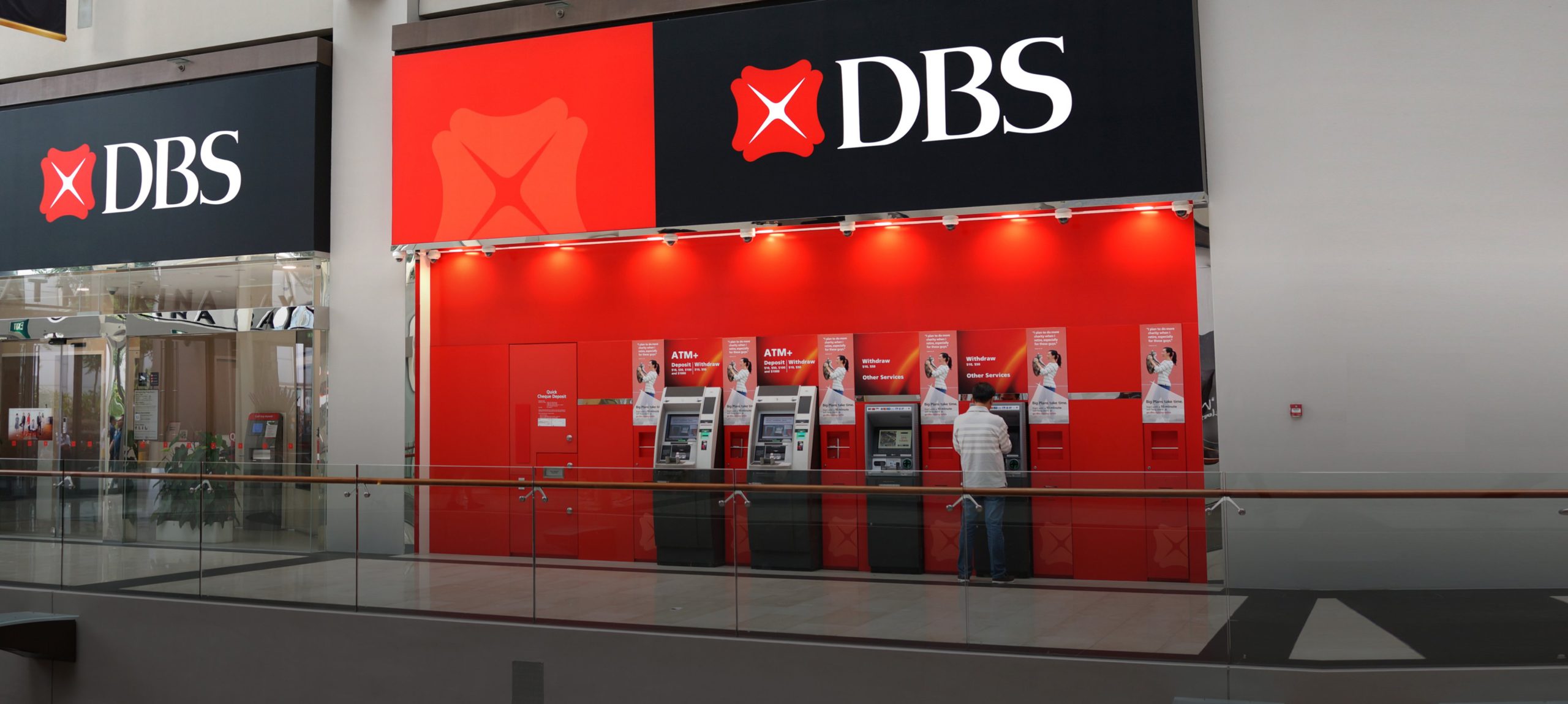India hit the peak of the COVID-19 infection curve in mid-September, with new daily cases dropping to sub-40k in November from ~90k two months prior. Worries over a post-festive period surge in infections has not yet materialised to the extent feared.
Nonetheless, the bleak global situation (US and Europe in particular) lends to caution, in midst of onset of cold weather and incremental reopening of contact intensive activities. The nationwide count remains under control, few states, however, witnessing a late surge.
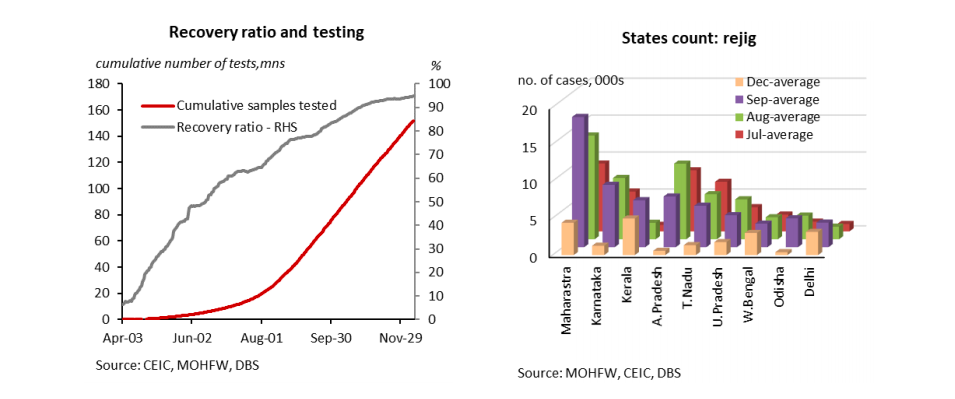
Barring a sharp re-escalation in cases, the Asian experience suggests local authorities are better prepared to handle a resurgence in infections, with “learning to live with the virus” also gaining currency.
Fatality rates have been low, recovery rates have improved to >94% vs 60—70% in Jul-Aug, and response function has improved compared to the first wave by way of additional testing centres, better medical infra (ventilators, PPE kits etc.). Even in the event of a sharp resurgence, a nationwide shutdown/ lockdown is ruled out.
States have already taken a proactive stance to monitor the evolving situation. Few restrictions have already been imposed on selective basis, including night curfews, delayed of reopening of schools, increase in penalties for not wearing masks, stepped up COVID-19 testing for inter-state travel especially inbound from more affected states.
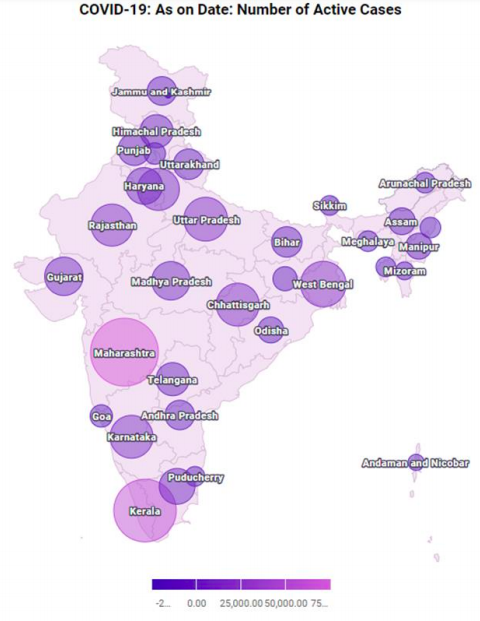
Authorities are laying the ground for vaccine readiness, with an effective production and distribution processes likely to be extremely crucial, made a bigger challenge due to the sheer scale of the population. Given the country’s well-known capabilities in pharmaceutical sector and being home to the world’s biggest vaccine maker, we expect India to play an
important role in global supplies of vaccines.
Amongst the front-runners who have met success in the third phase of trials, cold chain and distribution requirements of Pfizer-BioNtech (has sought emergency authorization in India) and Moderna are reportedly onerous.
Oxford-AstraZeneca’s is seen as a more viable alternative, easier to adopt and economical, especially for resource constrained developing markets. The latter also has a licensing agreement with the contract manufacturer Serum Institute of India (SII), world’s largest manufacturer of vaccines by volume. SII has sought emergency use authorization for the vaccine, as are the other vaccine producers.
Russia has reportedly signed deals with Indian companies to establish a production hub for Sputnik V vaccine of around 100mn doses a year and export doses next year.
Local companies are also in the fray, in midst of conducting trials after which emergency authorization will be sought. Mass vaccination is unlikely to be on the cards next year, with early access likely to priority segments, e.g. frontline workers etc., as and when made available. It is also largely understood that the entire population need not be vaccinated, with 50-70% likely to be targeted to effectively break the chain of spread. Any system tied down to Aadhar identification might be an area that authorities might explore. Until the vaccine rollout, prevention is still likely to be considered better than cure, heading to 2021.
First normalisation, then recovery
The economy staged a faster-than-expected normalisation in the September quarter, primarily due to pent-up demand, festive tailwinds, restocking demand, resumption in manufacturing activity, and gradual reopen of selected service sector activities, while government support was scaled back.
This helped provide a lift to Jul-Sep20 (2QFY) real GDP growth to -7.5% y/y vs -24% in the quarter before. In second half of the fiscal year (i.e. Dec20 and Mar21 quarters), auto sales, PMIs, GST collections continue to post positive trends, but the pace might moderate as pent up demand wanes and job security takes precedence, along with the passage of festivities. Globally, key export markets i.e. US and Europe continue to face high COVID-19 caseload, hurting demand. Sequential pace of lift is, thereby, likely to slow after the +23% q/q rise in 2QFY.
Headline GDP growth will, nonetheless, progressively turn less negative, assuming the pandemic remains under control. The DBS GDP Nowcast model marks a ‘V-shaped’ rebound for 2HFY21. For 2020, we expect GDP growth to contract -7.4% y/y and rebound a strong 7.6% in 2021, amongst the fastest in the region. Annual FY21 growth to average -8.0% y/y with upside risks. The FY22 forecast stands at 7.7%, which will start with a double-digit growth 20-25% y/y in the first quarter of the fiscal (i.e. 2Q21) on strong base effects.
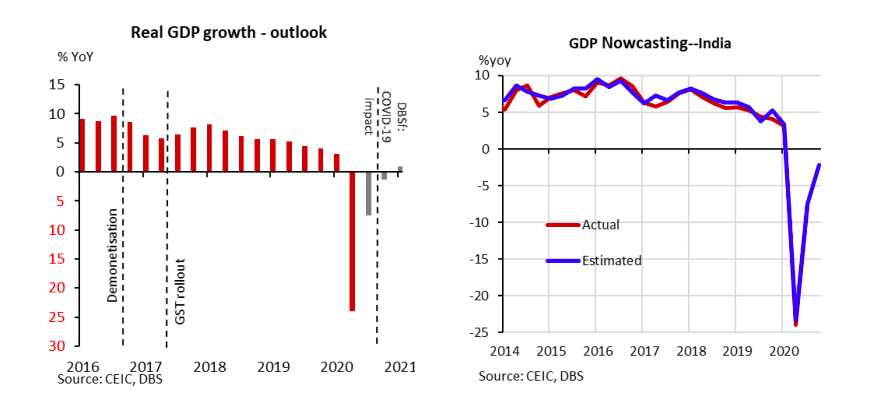
Our baseline assumption is for consumption to improve as businesses come back online resulting in a lift to income and employment prospects, as well as a larger shift from unorganized to organized sector, with any acceleration in vaccine availability to be an additional tailwind.
Resumption in public capex through infrastructure spending is expected to play a bigger role in improving revival prospects, whilst the boost in private sector profits and higher margins seen in 1HFY21 (largely due to cost rationalization, lower borrowing costs, subdued raw material expenses) moderates. Assuming US and Europe get an upper hand on the pandemic, pick-up in discretionary demand globally, would bode well for India’s exports.
From backburner to the front – medium-term constraints
Taking a step back from the ‘V-shaped’ rebound in FY21, we view this lift as a process of normalisation, which is bound to continue in 2021. Key catalysts by way of easy financial conditions, and vaccine availability will hasten the rebound, alongside our expectations of a global recovery (DBS 2021 Outlook: A bifurcated world).
Much of the recent snapback in activity has been on account of fading supply side restrictions. The nationwide lockdown earlier in the year and a gradual reopen subsequently, has still left the economy with permanent output loss (INR110mn in 1QFY, which eased to INR20mn 2Q as reopening began), which will leave nominal GDP lower in end-FY21 vs end-FY20. Per capita GDP (on PPP basis) is likely to recover to pre-pandemic levels by 2022.
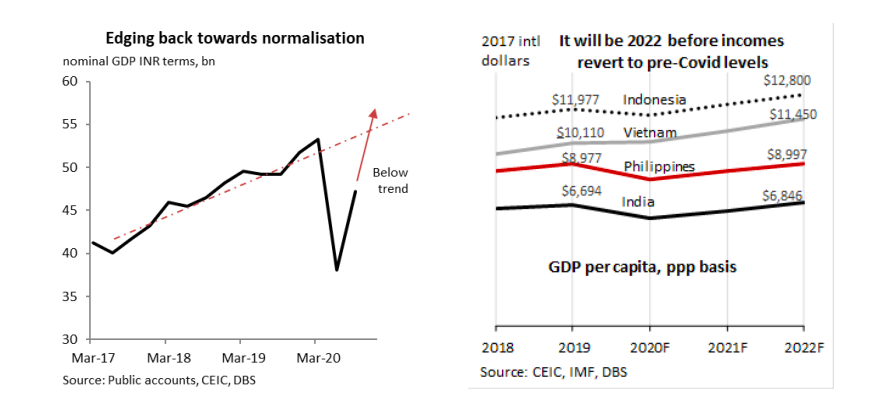
Amongst few of the priorities that are likely to emerge are, firstly, the pandemic has likely added to consumption headwinds, even as pressure on household balance sheets eased through higher savings at the cost of capex. Between FY14 to FY19, nominal household disposable income grew by an average of 6 percentage points lower than the five years prior.
Consumption expenditure moderated more slowly, helped by an increase in borrowings and concurrently resulting in slower accretion to savings. A RBI study on household finances [link] revealed that households are also exposed to high levels of unsecured debt (a little more than half), which includes debt taken from non-institutional sources, which keep
households vulnerable to a long period of high interest payments.
Ahead of the health crisis, the sustained overhang of slowing disposable incomes had begun to moderate the appetite for leverage-driven consumption, reflected in lower household leverage ratios in FY20, alongside slowing bank credit for personal loans. This trend likely extended into FY21 as the pandemic hurt incomes.
Deleveraging is likely to coincide with higher precautionary savings (currency, deposits etc.) – see chart on left below – pointing to a likely subdued consumption beyond the normalisation cyclical rebound next year.
Secondly, employment generation is of paramount importance. Labour force in India is about 500mn, with a little more than half constituting of rural workers and rest urban. Over the next decade, India will add c125mn people to the workforce (working age population), likely one of the biggest net increases in emerging markets. To absorb this workforce, demand and supply responses will be crucial. Supply consisting of labour
upskilling and productivity enhancement. Productivity has moderated in recent years, while the mismatch between skills levels that people have and employer requires remains high. Policy action has been initiated to bridge this deficit, but calls are to raise investment into education, from primary to tertiary levels. Demand to create viable jobs to keep up with workforce growth.
A 2014 RBI paper [link] highlighted that at an aggregate level, agriculture which employs the largest percentage of the
rural population has negative elasticity, i.e. employment does not move in sync with growth, which might be leading to regular movement of people out of agriculture to other sectors in search for productive and gainful employment. By contrast, utilities, manufacturing, construction, services display high positive elasticity. The recent push to attract
manufacturing through local and foreign participation another effort in this direction (discussed later in the note).
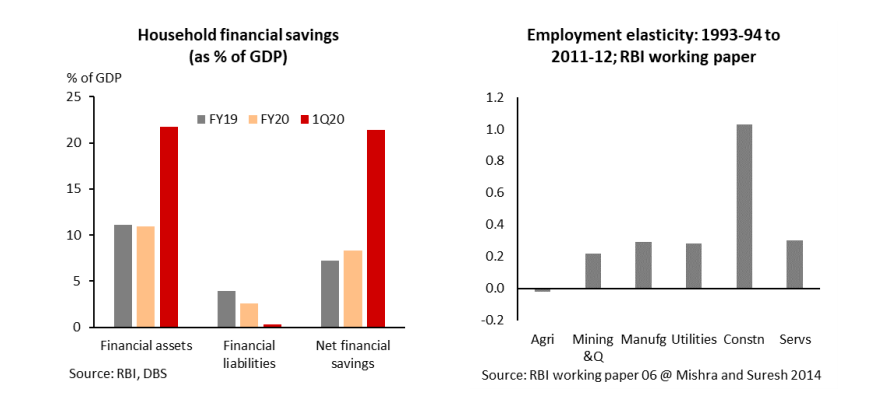
Lastly, balance sheet concerns of the other economic agents i.e. corporate sector, government and banks will restrain a sustained rebound in growth (India: Dissecting the slowdown and likely recovery). To preserve financial sector stability in midst of the pandemic, loan moratoriums, freeze in the insolvency proceedings, a two-year recast window for the vulnerable and most affected sectors etc. were announced, which will suppress near-term pain. Nonetheless, nonperforming ratio is bound to tick higher from Mar20’s 8.5%, particularly for accounts that were already deemed special mention/ bad loans heading into the health crisis.
• Monetary policy will stay focused on anchoring rates at low levels:
After 115bps cuts in 2020, above target inflation will narrow the room for the central bank to further outright rate cuts, keeping policy on a long pause next year. Two-way forces are likely in 2021 – supply-side disruptions, passage of seasonal drivers and favourable base effects will cap inflation, but higher commodity prices (industrial metals, oil etc.), demand recovery and return in manufacturers’ pricing power will keep 2021 inflation above target i.e. from 6.7% in 2020 to 4.2% in 2021.
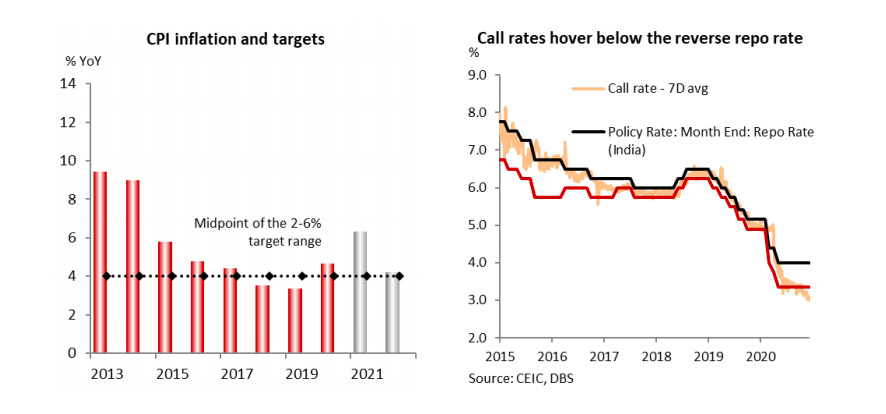
The RBI will be focused on anchoring rates, through firstly, strong dovish guidance into 2021, which will reinforce the central bank’s intent to keep conditions accommodative via surplus liquidity, financial sector stability and bond market support. Preference will be to tap regular channels e.g. reverse repo operations to modulate the liquidity surplus and bring short-term rates (commercial paper, 90- day T-bill, weighted call money rate etc.) back towards the reverse repo i.e. lower end of the policy corridor, rather than specific measures to soak up part of the transient surfeit.
Any specific measures to drain liquidity and correct distortions in money market rates might have been misinterpreted as a policy signal, leading to premature tightening in financial conditions and hardening in bond yields.
Secondly, bond market support would be maintained through open market operations (net infusion INR2.3trn FYTD) as well as liquidityneutral operation twists. Concurrently, if the central bank incrementally eases its bearish grip on the rupee, that will also help scale back additional liquidity boost from persistent FX intervention.
Lastly, we expect policy rates to settle into a long pause into 2021, akin to the post-global financial crisis period, when policy rates were held unchanged for nearly ten months. Maintaining an accommodative bias will be tested when headline GDP growth surges to double digits in the June 2021 quarter due to low base effects, while inflation comes off the boil.
• Fiscal consolidation expected to resume
Multiple phases of pandemic support packages were announced to defend against pandemic’s economic fallout, however, cognizance on the limited fiscal headroom led total support to be modest at ~2% of GDP additional spending via higher allocations to the rural employment scheme, cash handouts and free food provisions, interest free capex support to states, special festival advance amongst others, with the rest by way of credit guarantees, liquidity support by the central bank and medium-term reforms.
At the half year mark of FY21, the fiscal math points to weak revenue collection, but accompanied by slower spending. This was intended to limit the scale of fiscal slippage, but has weighed on growth, as evidenced in 3Q20 (i.e. 2QFY) numbers. In first seven month of FY21 (Apr-Oct20), the fiscal deficit is 20% over the budgeted estimate, on the back of tax and non-tax receipts at a third of target, divestment at less than 10% and overall revenues at 34% (vs 46.2% same time last year). Expenditure is, however, lagging last year’s runrate at 54.6% of budget vs 60% same period last year.
Ministry-wise data, unsurprisingly, reveals a rejig in priorities: a) slower disbursements in previously active sectors i.e. road and highways and heavy industries (a third of budgeted disbursed vs 56% last year); b) sectors where COVID-19 measures are in the forefront in 2Q20 (1QFY) i.e. rural, health, public distribution and farm sectors are running above trend in 3Q20 (2QFY).
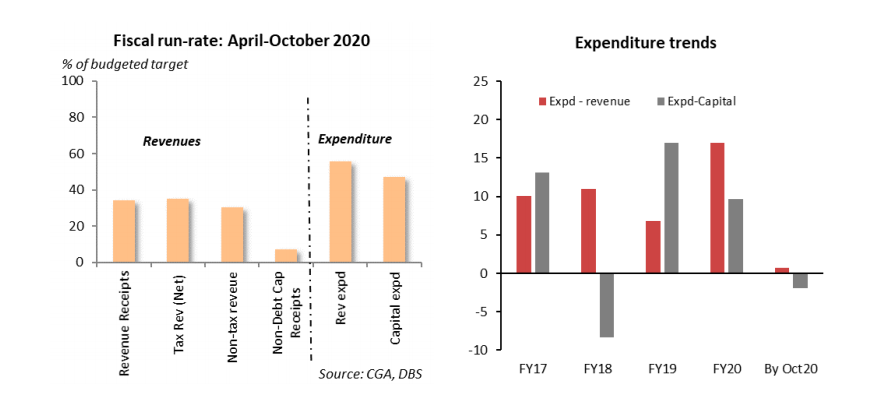
For the year, on the positive end, the unlocking process and resultant improvement in economic activity should provide a fillip to tax and non-tax receipts. Amongst the main heads of direct taxes i.e. corporate and income, latter continues to bridge the extent of shortfall but corporate tax collections lag. There are reasons to be optimistic on the latter, following stronger-than-expected earnings reports in the past quarter, improving capacity utilisation and fading base effects on last year’s corporate rate cuts. Indirect tax revenues fared better owing to better fuel excise duty collections and catch-up in GST revenues.
For full-year FY21, based on BE (budgeted estimate) nominal GDP calculations, total expenditure would have fallen by 1% of GDP and revenues by a steep 8%. However, the full-year math is somewhat saved by a collapse in nominal GDP (denominator effect). The chart below highlights that the wider FY21 deficit is likely to a combination of weaker revenues – tax collections (direct and indirect while excise duties fare better) as well as non-tax (divestments), and a modest
increase in total expenditure primarily revenue spending, while capex is scaled back. Netting all the above, the full-year deficit is likely to be closer to -8% of GDP in FY21 vs budgeted -3.5%.
A sharper expenditure compression might limit the deterioration in the fiscal balance. States are likely to post a deficit shortfall of -4.5% of GDP, making way of higher revenue account spends by scaling back capex allocations. Gross borrowings have been pegged at INR12trn in FY21, which might face some upside (INR1-1.5trn) in the March 2021
quarter when the strength in annual revenues becomes clearer.
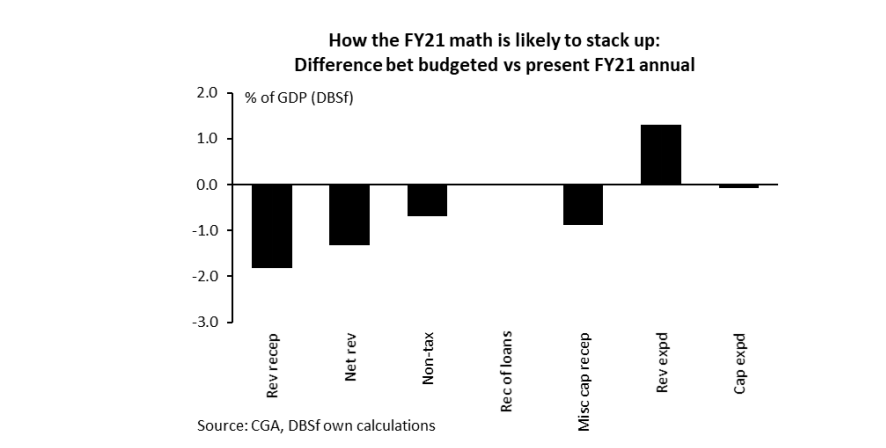
The centre’s fiscal consolidation is likely to be back in discussion when the FY22 Budget is outlined in February 2021. The FY22 fiscal deficit might be pegged at 7% of GDP, factoring in a strongly positive nominal GDP growth (as real GDP gets a boost from base effects), higher fuel excise revenues, better tax collections, which will help offset higher social spending and health outlays. There might also be overtures to compensate this year’s revenue shortfall by an increase
in taxation for high net worth individuals as well as sin taxes, for instance. The consolidated debt level is likely to stay elevated at 85% of GDP and 83% of GDP this year and next.
• External balances are well-buffered
India is faring well on most external vulnerability indicators, helped also by a low global rate environment and weak US dollar in 2020. Foreign reserves have risen to a record high of US$575bn by Nov20, surging by $95bn this fiscal year, with the accumulation at the fastest pace in a decade.
Coverage ratios are healthy, with short-term external debt, on original maturity, at a fifth of reserves and off taper
tantrum levels (see chart on left). Total external debt (TED) to reserves ratio has eased markedly to 103 in 3Q20 vs ~145 in 2013, with a likelihood that the reserves stock would exceed TED by end2020. Import cover is at a comfortable 20x months vs 7x during the 2013 taper tantrum. India’s reserves also rank high vs regional peers on the IMF’s reserve appropriateness gauge.
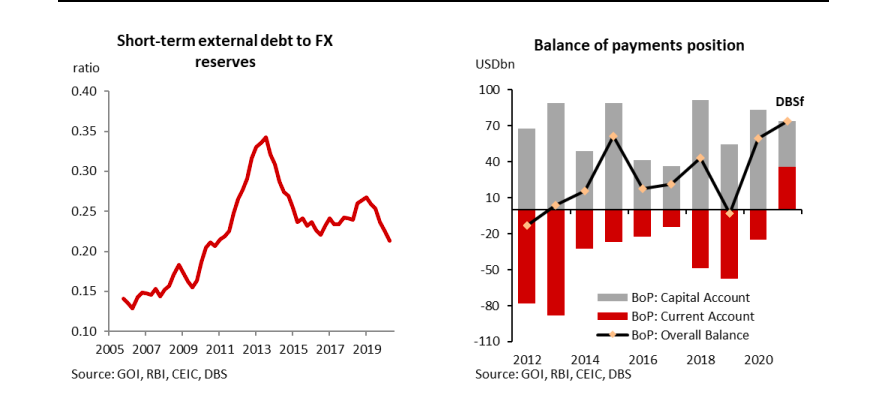
Growth impulses will also matter to external balances, primarily current account and balance of payments, just as somber recovery expectations manifest as weak imports. India registered a record high current account surplus in 2Q20 (1QFY21) at $19.8bn i.e. 3.9% of GDP. This takes 1H current account surplus to $20bn i.e. +2% of GDP.
Sharp reduction in the merchandise trade deficit (lower imports vs exports) was the main raison d’etre for the better math, which in turn reflects weak domestic demand due to the lockdown, along with weak commodity demand/ prices. One silver lining was the resilience in services trade receipts due to higher software exports, which only moderated marginally despite the pandemic, reinforcing India’s competitive advantage.
Capital account performance was less stellar in 2Q as net FDI turned negative, only partly offset by a surplus in portfolio flows. With external commercial borrowings also slipping in the quarter, the capital account surplus narrowed. The large current account surplus, however, made up for the rest and pushed the balance of payment surplus to $19.8bn.
FY21 current account balance is likely to turn in 1.4% of GDP surplus, factoring in a gradual increase in goods trade deficit as activity rebounds, resilient service trade receipts and only a moderate knock on effect on remittances. Notwithstanding further normalisation in activity in FY22 which might lift imports, the current account balance is likely to remain smaller than <-0.5% of GDP.
Policymakers face the impossible trinity. What gives?
At this juncture, the central bank is juggling a) a dollar deluge; b) while ensuring FX stability; c) and keeping bond yields low; just as inflation plays spoilsport. Ultra-accommodative policies pursued (QE and rates converging towards the zero-bound) by most pandemic-affected advanced economies have accentuated the gush of liquidity to emerging markets. In India’s case, foreign equity inflows have totalled $21bn since April, eclipsing debt outflows.
These coincided with by offshore borrowings by domestic financial institutions, and dealspecific inflows in addition to $39bn gross FDI flows (April-Sept). This comes at a time of limited absorptive capacity as the current account
is on course to register a surplus this year and resulting in two years of back-to-back balance of payment surpluses (FY20 $59bn), has resulted in a dollar surfeit.
Faced by this dollar deluge, the central bank returned to the track it has pursued in the past 4-5 years, where inflows are absorbed to build reserves – the stock has risen by $94bn since March 2020 and $105 billion since end-2019. Persistent intervention (via dollar buying) on the FX front had added to local liquidity surplus. This strategy has, however, been usurped by elevated inflation.
With policy on a balance beam, on FX, official preference is to soak dollar inflows to keep rupee on an even keel. This has seen the INR surface as the regional underperformer vs US$ year-to-2020, with small 1.1% gain vs dollar vs
Philippine peso at +8.6% up or Chinese yuan at +9.1%. Given the cost of keeping the INR on a weak footing, the currency might be given some leeway to catch-up with the regional uptrend in 2021.
The RBI likely to ease up its grip on the INR, whilst focusing on mainstream policy and bond market stability. Over the next twelve months as the current account dynamics reverse and return to deficit territory on higher domestic demand stoking imports, part of the dollar absorptive capacity will also be back in the financial system. This will relieve pressure on the central bank to put a strong defense against flows distorting stability in the currency markets.
Contours of the manufacturing push and ‘Self-Reliant’ India policy India’s new manufacturing push, referred to as ‘Atmanirbhar Bharat’ i.e. Self-Reliant India announced in May 2020, is expected to breathe life into the ‘Make in India’ program launched back in 2014. The latter was intended to raise the share of manufacturing GDP ratio to 25% by
2025, with positive multiplier effects for the broader economy. The sector’s share has, however, been largely steady in the six years since, at about 17-18% with real growth rate slowing to 5% in the past four years vs FY16’s double-digit rise.
The framework of ‘Self-Reliant India’ push is a work-in-progress. Inferring from official commentary, likely priorities are a) expansion of the domestic manufacturing base; b) part of a) is being sought through import substitution efforts; c) sharper industry focus; d) tax and fiscal incentives; e) continue with structural and regulatory reforms.
Notably, a global shift towards a more protectionist and inward looking trade policy has been underway in recent years, further hastened by the US-China trade spat. For instance, recent China’s dual circulation strategy also seeks to prioritise strengthening of domestic demand and technological innovation over closer integration with the outside world. An analysis of India’s imports (see chart) highlights that the high share of raw materials and intermediate goods
at two-third of total purchases, signaling high dependence of the manufacturing sector for inputs.
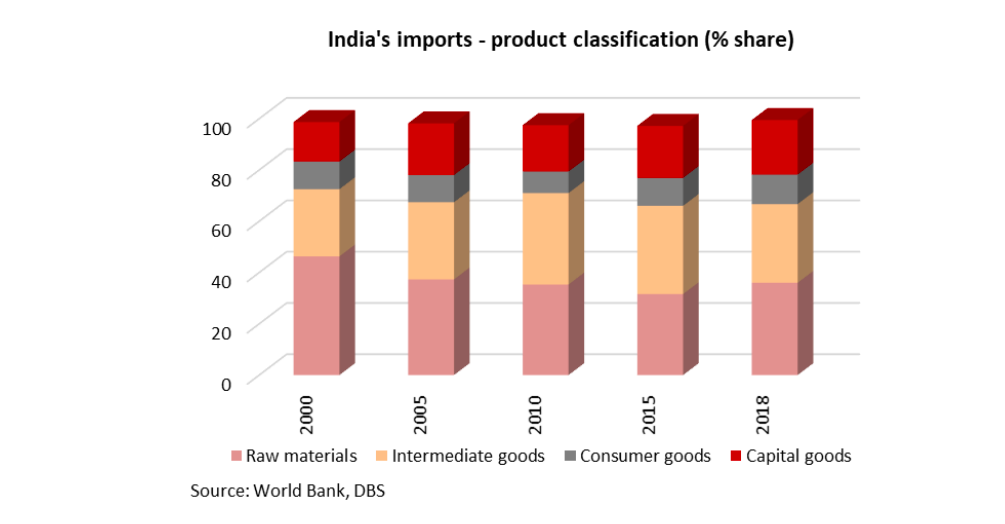
Of these, apart from oil, defense, consumer electronics, pharma, solar cells/ panels, auto-components etc. make a sizeable part of the import bill, where domestic alternatives are being sought. The share of imports that attract duties has been falling over the past two decades (see chart on left), nonetheless a combination of tariffs, non-tariff
barriers as well as export-related measures are likely to be tapped to incentivize domestic manufacturing. The effective applied weighted.
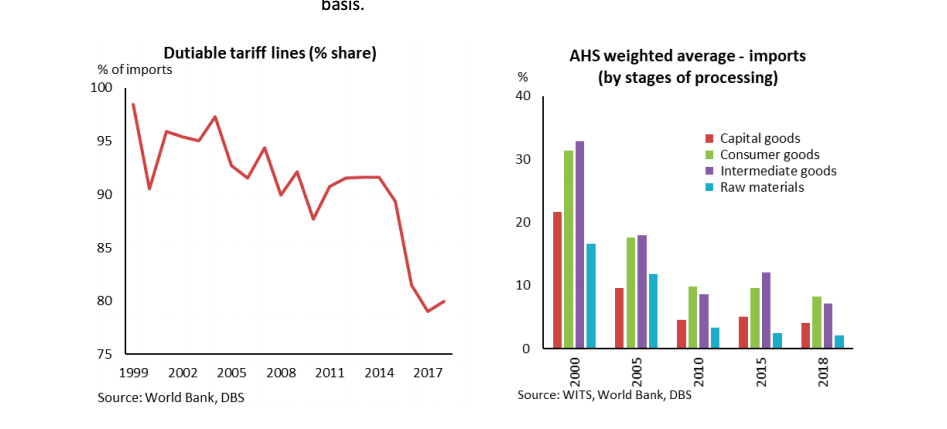
Historical experience with pursuing the import substitution strategy has carried pitfalls, where in higher tariff/ non-tariff barriers might directly slow imports but not necessarily translate into either higher output or materially improve productivity. This, we believe, has prompted authorities to also build in an export-oriented strategy under the same umbrella. On a more forward-looking basis, deeper integration into Global Value Chains (GVCs), is an option, which we will discuss in a separate note.
For a start, the domestic manufacturing restart is being pursued at a sectoral level, with specific incentives for a specified list of sectors, tied to production targets, termed as Production Linked Incentives (PLI) i.e. incentive of 4-6% on incremental sales (over base year FY20) over five years. The ball was set rolling with the electronics sector targeting
manufacturing of mobile phones and its components, considering, i) after oil, electronics is the largest import item; ii) raise electronic exports and be a part of the global supply chain. While import dependence remains high, encouragingly exports have been rising ~35% on average in the last two years, on value basis.
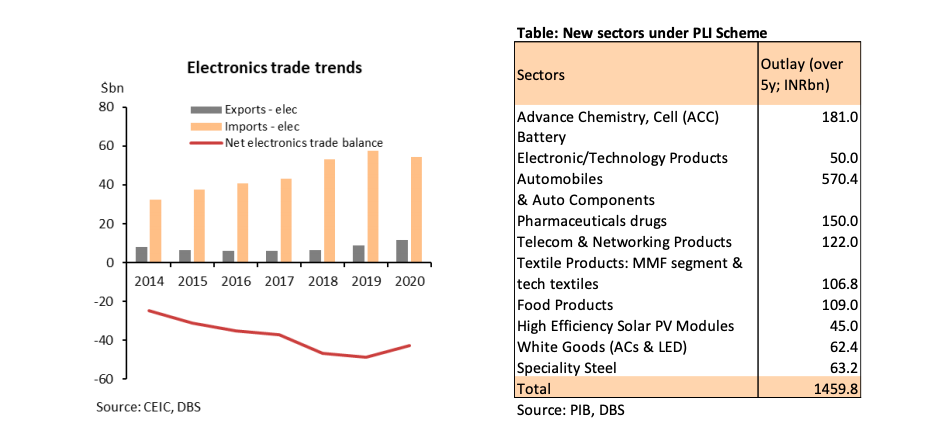
Of the 22 companies that had applied, 16 have named as eligible, with a mix of domestic (e.g. Lava, Bhagwati, Padget etc.) and foreign (Samsung, Foxconn Hon Hai, Rising Star, Wistron and Pegatron etc.). companies. Foxconn Hon Hai, Wistron and Pegatron are contract manufacturers for Apple iPhones. Apple (37%) and Samsung (22%) together account for nearly 60% of global sales revenue of mobile phones and this scheme is expected to increase their manufacturing
base manifold in the country, according to the government.
Industry practitioners have sought an extension of the PLI scheme to other electronic segments including hardware like laptop and tablet manufacturing, two-thirds of which are currently imported from China, according to the India Cellular & Electronics Association. Encouraged by the positive reception, the PLI scheme has been extended to ten more sectors in November including auto and auto components, textiles, food products, specialty steel, telecom and networking products etc., with the approved expenditure over the coming 5 years likely to equal INR1.45trn (0.8% of FY21f GDP). Pulling
together this Rs 1.5 trillion (see table above) and INR513bn announced earlier, cumulative outlay towards this scheme is near INR2.0trn. The relatively smaller size of support (per sector), benefits only on incremental sales from last year as a base year and further clarity on the support measures, are aspects which need to be worked on.
On c), d) and e) tax and fiscal incentives are in centre stage. Apart from the rollout of the goods and services tax system in 2017 to improve predictability of the tax structure and liabilities, corporate tax rate was cut sharply in Sept19, from 30% to 22% (excluding surcharges) for new manufacturing companies and 25% for firms that don’t seek any special tax incentives/ exemptions, in a bid to close in with the Asian peers.
Notably, few ASEAN countries have also followed a similar path to draw in more investors, with Thailand and Indonesia also announcing lower tax incidence for potential investors.
Structural and regulatory reform push will continue.
Simplifying and modernizing labour laws has been one such focal point, with plans to assimilate over 40 laws to four codes i.e. wages, industrial relations, social security, and lastly occupational working conditions, alongside nearly 1500 sections into less than 500. For instance, the Code of wages law was enacted in August 2019, with draft rules published in mid-2020 seeking to consolidate four laws covering wages and remuneration.
Keeping up with times, coverage might be extended to gig workers, home based workers, freelancers etc. Broader proposed changes are an important legislative push, considering only a fifth of the total 63mn enterprises have registered under the unified indirect tax system, highlighting the dominance of small and micro enterprises
who face an onerous regulatory burden.
With labour falling under the concurrent list of the constitution, parliament and states legislatures will be required to work in tandem. Not only is there a need for intra-state standarisation in procedures but also states will be required to incentive enterprises to scale up, as well as review and reduce multiple processes to improve the ease of doing business for domestic and foreign investors, alike.
Easing land acquisition alongside other factors of production will materially improve the ease of doing business and lower related costs.
Precedence over multilateral trade agreements like the RCEP
Concurrent to efforts to expand the manufacturing footprint, a debate over India’s move to decide against joining the Regional Comprehensive Economic Partnership (RCEP) has ensued. In the present configuration, the trade impact of RCEP should be mainly on the countries that currently don’t have bilateral FTAs with each other, i.e., China-Japan and Japan-South Korea, in our view. The door has been left open for India to return to the negotiating table, but India’s
official stance is one of caution considering the already lop-sided trade balance it runs with the RCEP members, especially China (RCEP & India Weighing the benefits of regionalism).
Limited benefits from previous trade agreements and ongoing push to even out the level-playing field in manufacturing will keep India reticent of joining multilateral trade agreements in the near-term. Incremental real income gains of 1.1%
can accrue if India were to join the RCEP bloc, whilst standing to lose marginally -0.1% if it stays out, according to a working paper by the Peterson Institute for International Economics [link].
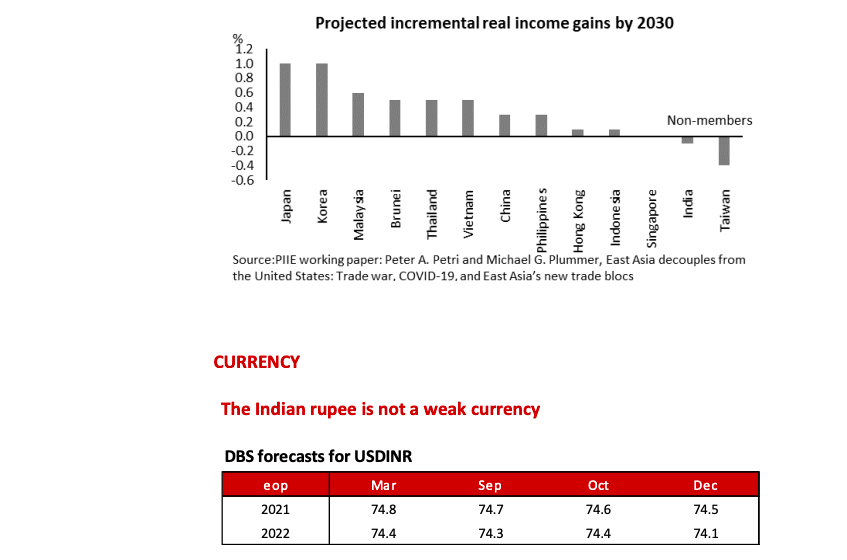
Although India has the second-most COVID-19 infections in the world, several factors have improved sufficiently for the Indian rupee to wean off its depreciation path in favour of consolidation during its projected economic rebound in 2021-22. The INR was not left out of the recovery in Emerging Asia but its appreciation pace was notably slower than its peers. This, however, did not imply that INR was a weak currency. Instead, it reflected a policy bias to keep the exchange rate stable in a weak USD environment.
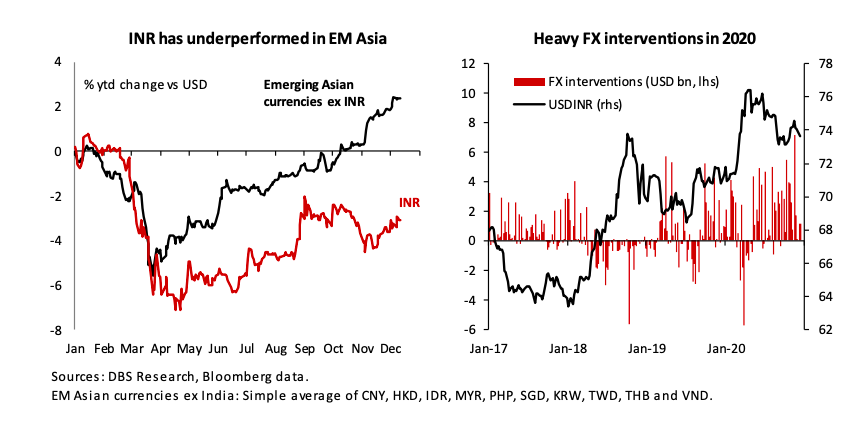
Apart from heavy interventions from major state banks in the futures markets, authorized dealer banks were permitted to allow Indian companies to set-off their export receivables against import payables. Since 1 June, the Reserve Bank of India has allowed domestic banks to trade in the offshore non-deliverable forward (NDF) market to curb volatility in the exchange rate. This has paved the way for RBI interventions in the offshore market to curb sharp currency fluctuations which in turn will help multinational companies to save hedging costs and level the playing field for local banks to better serve their overseas clients.
INR is underpinned by stable balance of payments. Foreign reserves have, as of 4 December, increased by a whopping USD123bn this year to a record high of $580 billion.
Investor confidence has rebounded.
The Bombay Sensex Index has risen 11.8% ytd to a new life-time high around 46,000 on 9 December on record foreign equity investments. Externally, the outlook for Asia has brightened after the US elections on prospects of less turbulent and more predictable US-China relations under US President-elect Joe Biden. Domestically, India’s economic outlook has brightened after GDP growth improved to -7.5% yoy in 3Q20 from -23.9% in the Apr-Jun quarter. More importantly, India has led the world in securing COVID-19 doses in a mass vaccination drive.
Our economist expects India to become the fastest growing economy in Asia in 2021; real GDP growth is forecast to rebound to 7.6% next year after a 7.4% recession in 2020.
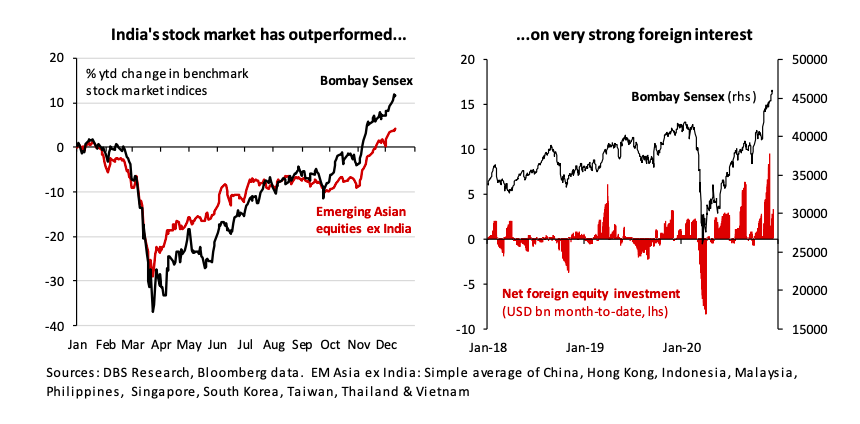
Therefore, it was understandable why investors shrugged off Moody’s decision in June to downgrade India’s long-term foreign currency debt rating by one notch to Baa3. Yet, there is little room for complacency. India’s sovereign debt ratings by Fitch, Standard and Poor’s and Fitch are one downgrade away from junk status. Our economist expects the
full-year budget deficit to come in around -8% of GDP in FY21 vs budgeted -3.5%. Close attention will be paid to fiscal consolidation intentions in FY22 Budget in February 2021.
Prioritizing growth, the central government will decide whether to introduce more flexibility into the RBI’s inflation targeting framework when it ends on 31 March 2021. RBI has stopped lowering rates after its last cut in May from CPI inflation holding firm above its 2-6% target. The central bank has been seeking a strike a balance between maintaining an accommodative stance (to ensure ample liquidity and provide credit to stressed sectors) and taming inflation. For now, the 10-year bond yield has been stable within 5.75-6.20% after the last rate cuts in May on the assumption for inflation to return into its official range next year (DBSf: 4.2% in 2021 vs 6.7% in 2020).
Overall, the INR is supported by high inflows and a buoyant stock market betting on an economic rebound. On the other hand, the upside in the INR has been capped by interventions in the short-term, and for the longer term, needs to be affirmed by India’s reassurances to return to a fiscal consolidation path and keep inflation stable.
RATES
Extend duration to the intermediate tenors Domestic INR liquidity is flush and will likely remain so in 1H21, keeping
short-term INR rates anchored. While persistently high inflation may have prevented a more aggressive rate cut stance, from a rates perspective, liquidity is more important in driving rate returns. Flush liquidity conditions can be explained by several factors.
Fundamentally, the current account slipped back into surplus as the economy slowed. On the policy front, the Reserve Bank of India appears to be leaning against rupee appreciation (the rupee is the worst performing Asian currency we track over a two-month period).
This resulted in a buildup of foreign reserves and banking system liquidity (which amounted to around INR6tn in late November). The impact on short-term rates is significant, with the 3M INR rate dipping below the reserve repo rate for the first time since 2009.
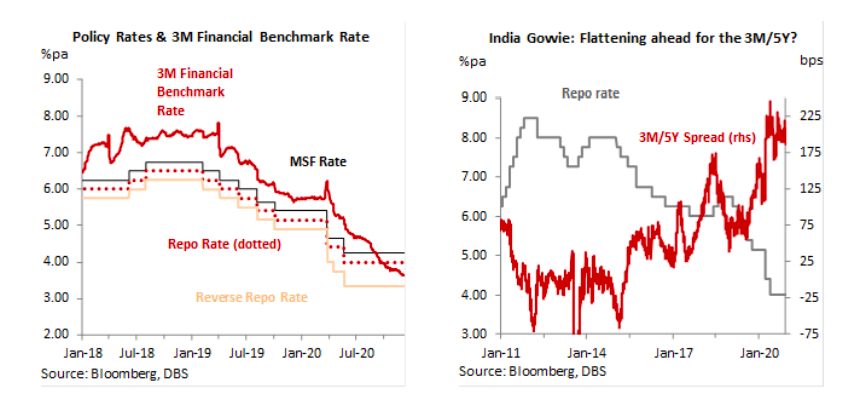
We think that current flush conditions will persist for several months and that investors will find extending duration out to the intermediate tenors to be attractive. The 3M/5Y segment of India government bond curve (at around 207bps) is already steep by historical standards. A combination of ample liquidity and loose monetary policy stance should provide positive spillover to the 5Y tenor. We are slightly wary of longer-term tenors. Our Asia Rates Valuation Indicator (ARVI)
suggests that India govvies are modestly overvalued compared to UST.





